|
|
|
Sort Order |
|
|
|
Items / Page
|
|
|
|
|
|
|
| Srl | Item |
| 1 |
ID:
152296
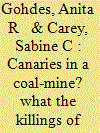

|
|
|
|
|
| Summary/Abstract |
An independent press that is free from government censorship is regarded as instrumental to ensuring human rights protection. Yet governments across the globe often target journalists when their reports seem to offend them or contradict their policies. Can the government’s infringements of the rights of journalists tell us anything about its wider human rights agenda? The killing of a journalist is a sign of deteriorating respect for human rights. If a government orders the killing of a journalist, it is willing to use extreme measures to eliminate the threat posed by the uncontrolled flow of information. If non-state actors murder journalists, it reflects insecurity, which can lead to a backlash by the government, again triggering state-sponsored repression. To test the argument whether the killing of journalists is a precursor to increasing repression, we introduce a new global dataset on killings of journalists between 2002 and 2013 that uses three different sources that track such events across the world. The new data show that mostly local journalists are targeted and that in most cases the perpetrators remain unconfirmed. Particularly in countries with limited repression, human rights conditions are likely to deteriorate in the two years following the killing of a journalist. When journalists are killed, human rights conditions are unlikely to improve where standard models of human rights would expect an improvement. Our research underlines the importance of taking the treatment of journalists seriously, not only because failure to do so endangers their lives and limits our understanding of events on the ground, but also because their physical safety is an important precursor of more repression in the future.
|
|
|
|
|
|
|
|
|
|
|
|
|
|
|
|
| 2 |
ID:
152298
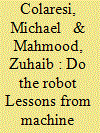

|
|
|
|
|
| Summary/Abstract |
Increasingly, scholars interested in understanding conflict processes have turned to evaluating out-of-sample forecasts to judge and compare the usefulness of their models. Research in this vein has made significant progress in identifying and avoiding the problem of overfitting sample data. Yet there has been less research providing strategies and tools to practically improve the out-of-sample performance of existing models and connect forecasting improvement to the goal of theory development in conflict studies. In this article, we fill this void by building on lessons from machine learning research. We highlight a set of iterative tasks, which David Blei terms ‘Box’s loop’, that can be summarized as build, compute, critique, and think. While the initial steps of Box’s loop will be familiar to researchers, the underutilized process of model criticism allows researchers to iteratively learn more useful representations of the data generation process from the discrepancies between the trained model and held-out data. To benefit from iterative model criticism, we advise researchers not only to split their available data into separate training and test sets, but also sample from their training data to allow for iterative model development, as is common in machine learning applications. Since practical tools for model criticism in particular are underdeveloped, we also provide software for new visualizations that build upon already existing tools. We use models of civil war onset to provide an illustration of how our machine learning-inspired research design can simultaneously improve out-of-sample forecasting performance and identify useful theoretical contributions. We believe these research strategies can complement existing designs to accelerate innovations across conflict processes.
|
|
|
|
|
|
|
|
|
|
|
|
|
|
|
|
| 3 |
ID:
152301
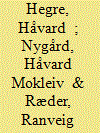

|
|
|
|
|
| Summary/Abstract |
Several studies show that internal armed conflict breeds conflict by exacerbating conditions that increase the chances of war breaking out again. Empirically, this ‘conflict trap’ works through four pathways: conflicts increase the likelihood of continuation, recurrence, escalation, and diffusion of conflict. Past empirical studies have underestimated the scope and intensity of the conflict trap since they consider the impact of conflict only through one of these pathways and rarely across sufficiently long time periods. This article shows that simulation and forecasting techniques are useful and indeed necessary to quantify the total, aggregated effect of the conflict trap, over long time periods and across countries. We develop a country-year statistical model that allows estimating the probability of no conflict, minor conflict, and major conflict, and the probabilities of transition between these states. A set of variables denoting the immediate and more distant conflict history of the country are used as endogenous predictors in the simulated forecasts. Another set of variables shown to be robustly associated with armed conflict are treated as exogenous predictors. We show that the conflict trap is even more severe than earlier studies have indicated. For instance, if a large low-income country with no previous conflicts is simulated to have two to three years of conflict over the 2015–18 period, we find that it will have nine more years of conflict over the 2019–40 period than if peace holds up to 2018. Conversely, if a large low-income country that has had major conflict with more than 1,000 battle-related deaths in several of the past ten years succeeds in containing violence to minor conflict over the 2015–18 period, we find that it will experience five fewer years of conflict in the subsequent 20 years than if violence continues unabated.
|
|
|
|
|
|
|
|
|
|
|
|
|
|
|
|
| 4 |
ID:
152299
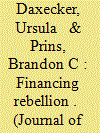

|
|
|
|
|
| Summary/Abstract |
A prominent explanation of the resource–conflict relationship suggests that natural resources finance rebellion by permitting rebel leaders the opportunity to purchase weapons, fighters, and local support. The bunkering of oil in the Niger Delta by quasi-criminal syndicates is an example of how the black-market selling of stolen oil may help finance anti-state groups. More systematic assessments have also shown that the risk and duration of conflict increases in the proximity of oil and diamond deposits. Yet despite the emphasis on rebel resource extraction in these arguments, empirical assessments rely almost exclusively on latent resource availability rather than actual resource extraction. Focusing on maritime piracy, this article argues that piracy is a funding strategy neglected in current research. Anecdotal evidence connects piracy in the Greater Gulf of Aden to arms trafficking, the drug trade, and human slavery. The revenue from attacks may find its way to Al-Shabaab. In Nigeria, increasing attacks against oil transports may signal an effort by insurgents to use the profits from piracy as an additional revenue stream to fund their campaign against the Nigerian government. The article hypothesizes that piracy incidents, that is, actual acts of looting, increase the intensity of civil conflict. Using inferential statistics and predictive assessments, our evidence from conflicts in coastal African and Southeast Asian states from 1993 to 2010 shows that maritime piracy increases conflict intensity, and that the inclusion of dynamic factors helps improve the predictive performance of empirical models of conflict events in in-sample and out-of-sample forecasts.
|
|
|
|
|
|
|
|
|
|
|
|
|
|
|
|
| 5 |
ID:
152293
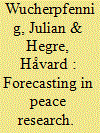

|
|
|
|
|
| Summary/Abstract |
Prediction and forecasting have now fully reached peace and conflict research. We define forecasting as predictions about unrealized outcomes given model estimates from realized data, and predictions more generally as the assignment of probability distributions to realized or unrealized outcomes. Increasingly, scholars present within- and out-of-sample prediction results in their publications and sometimes even forecasts for unrealized, future outcomes. The articles in this special issue demonstrate the ability of current approaches to forecast events of interest and contributes to the formulation of best practices for forecasting within peace research. We highlight the role of forecasting for theory evaluation and as a bridge between academics and policymakers, summarize the contributions in the special issue, and provide some thoughts on how research on forecasting in peace research should proceed. We suggest some best practices, noting the importance of theory development, interpretability of models, replicability of results, and data collection.
|
|
|
|
|
|
|
|
|
|
|
|
|
|
|
|
| 6 |
ID:
152295
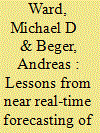

|
|
|
|
|
| Summary/Abstract |
Since 2014, we have been producing regular six-month forecasts of the probability of irregular leadership changes – coups, rebellions, protests that result in state leader changes – for most countries in the world for the Political Instability Task Force (PITF). During 2015, we issued new forecasts each month, with a delay as short as five days and no longer than two weeks into each six-month forecasting window. This article describes the approach we use to generate our forecasts and presents several examples of how we present forecasts. The forecasts are derived from a statistical ensemble of seven thematic models, each based on a split-population duration model that aims to capture a specific argument or related set of covariates. This approach is modular in that thematic models can be swapped out or new models integrated, and it lessens the need for generalist ‘kitchen sink’ models. Together, the models achieve high out-of-sample accuracy. Based on our experience, we draw conclusions about the practical, policy, and scientific aspects of this and similar undertakings. These include thoughts on how to evaluate and present forecasts, the potential role of ensembles in model comparison, the role of ensembles and prediction in causal research, and considerations for future efforts in forecasting and predictive modeling.
|
|
|
|
|
|
|
|
|
|
|
|
|
|
|
|
| 7 |
ID:
152305
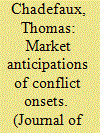

|
|
|
|
|
| Summary/Abstract |
Does the recurrence of wars suggest that we fail to recognize dangerous situations for what they are, and are doomed to repeat the errors of the past? Or rather that policymakers correctly anticipate the consequences of their actions but knowingly choose conflict? Unfortunately, little is known about how well wars are anticipated. Do conflicts tend to come as a surprise? I estimated the risk of war as perceived by contemporaries of all interstate and intrastate conflicts between 1816 and 2007. Using historical financial data of government bond yields, I find that market participants tend to underestimate the risk of war prior to its onset, and to react with surprise immediately thereafter. This result illustrates how conflict forecasts can be self-fulfilling or self-defeating. Present predictions may affect future behavior, such that wars may be less likely to occur when they are predicted, but more likely when they are not. I also show that the forecasting record has not improved over the past 200 years, and that wars involving democracies lead to greater market shocks. These findings also have implications for the way decisionmakers respond to new information, and how audiences perceive the risk of war and hence their leaders’ actions.
|
|
|
|
|
|
|
|
|
|
|
|
|
|
|
|
| 8 |
ID:
152300
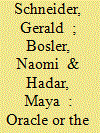

|
|
|
|
|
| Summary/Abstract |
The forecasting literature has come to mistrust the predictions made by experts who forecast political events in mass media. Distinguishing between judgements made by one or few individuals (‘oracles’) and assessments made by larger groups (‘crowds’), we contrast journalistic predictions with forecasts stemming from the financial industry. These two competing views were evaluated in a quantitative analysis of the ex ante success of 24 ceasefire agreements in various conflicts which took place in the Levant from 1993 to 2014. Our analysis compares the forecasts appearing in press commentaries (Haaretz, Jerusalem Post and New York Times) with the expectations that the Tel Aviv Stock Exchange had about the stability of these cooperative efforts. To evaluate the predictions of these very dissimilar sources, the effectiveness of the ceasefires was analysed through the number of violent events following the official start of the truce. The analysis shows that the financial industry performs better than the media industry in the comparative evaluation of ceasefire forecasts, but that neither source provides sufficiently accurate predictions. The partial support for the crowd thesis is discussed in light of recent literature that resuscitates the usage of well-trained experts for forecasting purposes, but warns against the dramatizing predictions of media pundits.
|
|
|
|
|
|
|
|
|
|
|
|
|
|
|
|
| 9 |
ID:
152304
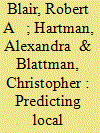

|
|
|
|
|
| Summary/Abstract |
Riots, murders, lynchings, and other forms of local violence are costly to security forces and society at large. Identifying risk factors and forecasting where local violence is most likely to occur should help allocate scarce peacekeeping and policing resources. Most forecasting exercises of this kind rely on structural or event data, but these have many limitations in the poorest and most war-torn states, where the need for prediction is arguably most urgent. We adopt an alternative approach, applying machine learning techniques to original panel survey data from Liberia to predict collective, interpersonal, and extrajudicial violence two years into the future. We first train our models to predict 2010 local violence using 2008 risk factors, then generate forecasts for 2012 before collecting new data. Our models achieve out-of-sample AUCs ranging from 0.65 to 0.74, depending on our specification of the dependent variable. The models also draw our attention to risk factors different from those typically emphasized in studies aimed at causal inference alone. For example, we find that while ethnic heterogeneity and polarization are reliable predictors of local violence, adverse economic shocks are not. Surprisingly, we also find that the risk of local violence is higher rather than lower in communities where minority and majority ethnic groups share power. These counter-intuitive results illustrate the usefulness of prediction for generating new stylized facts for future research to explain. Ours is one of just two attempts to forecast local violence using survey data, and we conclude by discussing how our approach can be replicated and extended as similar datasets proliferate.
|
|
|
|
|
|
|
|
|
|
|
|
|
|
|
|
| 10 |
ID:
152302
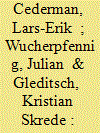

|
|
|
|
|
| Summary/Abstract |
Many scholars have detected a decrease of political violence, but the causes of this decline remain unclear. As a contribution to this debate, we revisit the controversy over trends in conflict after the end of the Cold War. While many made ominous predictions of surging ethnic warfare, Gurr presented evidence of a pacifying trend since the mid-1990s and predicted a further decline in ethnic conflict in an article on ‘the waning of ethnic war’. Leveraging more recent data on ethnic groups and their participation in ethnic civil wars, this study evaluates if Gurr was right about the decline of ethnic conflict, and if he was right for the right reasons. We assess whether an increase in governments’ accommodative policies toward ethnic groups can plausibly account for a decline in ethnic civil war. Our findings lend considerable support to an account of the pacifying trend that stresses the granting of group rights, regional autonomy, and inclusion in power-sharing, as well as democratization and peacekeeping.
|
|
|
|
|
|
|
|
|
|
|
|
|
|
|
|
| 11 |
ID:
152303
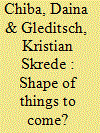

|
|
|
|
|
| Summary/Abstract |
We examine if dynamic information from event data can help improve on a model attempting to forecast civil war using measures reflecting plausible motivation and grievances. Buhaug, Cederman, and Gleditsch predict the risk of civil war using a horizontal inequality model with measures reflecting motivation and relevant group characteristics at the country level. The predictions from their model outperform in an out-of-sample forecast conventional country-level models of civil war, emphasizing vertical inequality and country characteristics. However, most grievance measures change little over time. We surmise that a model reflecting potential motivation for conflict can be improved with more dynamic information on mobilization and the behavior of actors. Our conjecture receives some support in the empirical analysis, where we consider both conflict onset and termination over territorial and governmental incompatibilities in the Uppsala/PRIO Armed Conflict Data, and find some evidence that event data can help improve forecasts. Moreover, models with the original grievance measures do better than purely event based models, supporting our claim that both structure and event based components can add value to conflict prediction models. However, the contribution of events to improving predictive power is modest and not entirely consistent, and some types of conflict events seem easier to forecast than others.
|
|
|
|
|
|
|
|
|
|
|
|
|
|
|
|
| 12 |
ID:
152297
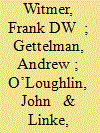

|
|
|
|
|
| Summary/Abstract |
How will local violent conflict patterns in sub-Saharan Africa evolve until the middle of the 21st century? Africa is recognized as a particularly vulnerable continent to environmental and climate change since a large portion of its population is poor and reliant on rain-fed agriculture. We use a climate-sensitive approach to model sub-Saharan African violence in the past (geolocated to the nearest settlements) and then forecast future violence using sociopolitical factors such as population size and political rights (governance), coupled with temperature anomalies. Our baseline model is calibrated using 1° gridded monthly data from 1980 to 2012 at a finer spatio-temporal resolution than existing conflict forecasts. We present multiple forecasts of violence under alternative climate change scenarios (optimistic and current global trajectories), of political rights scenarios (improvement and decline), and population projections (low and high fertility). We evaluate alternate shared socio-economic pathways (SSPs) by plotting violence forecasts over time and by detailed mapping of recent and future levels of violence by decade. The forecasts indicate that a growing population and rising temperatures will lead to higher levels of violence in sub-Saharan Africa if political rights do not improve. If political rights continue to improve at the same rate as observed over the last three decades, there is reason for optimism that overall levels of violence will hold steady or even decline in Africa, in spite of projected population increases and rising temperatures.
|
|
|
|
|
|
|
|
|
|
|
|
|
|
|
|
| 13 |
ID:
152294


|
|
|
|
|
| Summary/Abstract |
Nighttime illumination can serve as a proxy for economic variables in particular in developing countries, where data are often not available or of poor quality. Existing research has demonstrated this for coarse levels of analytical resolution, such as countries, administrative units or large grid cells. In this article, we conduct the first fine-grained analysis of night lights and wealth in developing countries. The use of large-scale, geo-referenced data from the Demographic and Health Surveys allows us to cover 39 less developed, mostly non-democratic countries with a total sample of more than 34,000 observations at the level of villages or neighborhoods. We show that light emissions are highly accurate predictors of economic wealth estimates even with simple statistical models, both when predicting new locations in a known country and when generating predictions for previously unobserved countries.
|
|
|
|
|
|
|
|
|
|
|
|
|
|
|
|
|
|
|
|
|